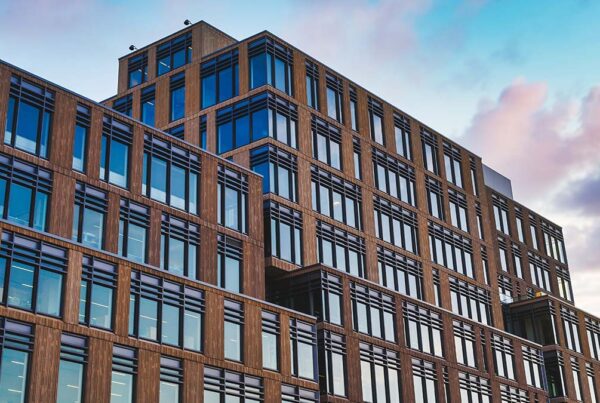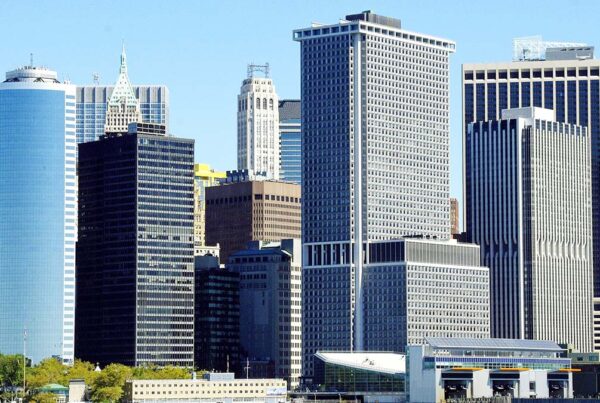
When you’re in the market for a new property, you must consider the commercial real estate loans and financing options available for your project.
Many new investors assume their personal credit score and financial track record will impact what commercial lenders are willing to lend. However, you may be surprised to learn that’s not always the case because lenders often focus more on the property’s ability to cover the debt payment and the overall loan-to-value ratio.
But not all commercial real estate loan types are created equal, and not all private lenders and traditional banks have the same qualification requirements or provide the repayment terms and interest rates. Therefore, it’s important to know what loan type or loan product might be best for each project ahead of time.
In this article, we’ll help you do just that. We’ll cover everything from a traditional commercial real estate loan or long-term loans to interest-only loans, short-term financing, and non-recourse loans. Let’s dive in!
Table of Contents
What is a commercial real estate loan?
A commercial real estate loan is a financial product used to purchase or renovate commercial properties such as office space, retail space, apartment buildings, and industrial buildings. Banks and other financial institutions provide these loans to businesses and investors with different terms and requirements than residential home loans.
Commercial real estate investors, developers, small business owners, and corporations commonly use the different commercial real estate loan types. Each type of commercial loan has strengths and weaknesses depending on the project, so deciding on what type of commercial loan product to use can drastically impact the project’s cash flow, returns, and exit opportunities.
What can you do with a commercial real estate loan?
Different types of commercial real estate loans provide different opportunities. Generally, commercial real estate loans are used to purchase or renovate commercial buildings, refinance existing commercial property debt, acquire land for development, and construct new commercial buildings.
Some commercial real estate loans can be better than others, depending on the project you want to pursue. For example, a conventional commercial real estate loan with a fixed interest rate may be best if you want to buy and hold a commercial property for five to fifteen years. However, a conventional loan is likely not the best commercial type if you want to purchase a piece of vacant land and build a new property. In the development case, a commercial construction loan is likely the best option, or a commercial hard money loan with interest-only payments if it’s a shorter project.
Let’s look at the different commercial real estate loan types and an overview of what they do so that you can deepen your understanding of what’s commonly available and how you might use each type of loan.
What are the different types of commercial real estate loans?
The seven most common types of commercial real estate loans in the U.S. include the following:
- Conventional Commercial Real Estate Loans (Traditional Loans)
- Commercial Hard Money Loans
- Small Business Administration (SBA) Loans
- Commercial Bridge Loans
- Commercial Blanket Loans (AKA Portfolio Loans)
- Commercial Construction Loans
- Commercial Mortgage-Backed Securities (CMBS) Loans (AKA Conduit Loans)
Now, let’s explore each type of commercial loan in more detail:
1. Conventional Commercial Real Estate Loans (AKA Traditional Loans)
Traditional Loans, often referred to as conventional commercial real estate loans, are comparable to residential home mortgages in that they frequently have a fixed interest rate, a set repayment duration, and are secured by the real estate itself.
Buy-and-hold investors who wish to buy a building and hold it for three to ten years frequently use traditional loans. Lenders frequently offer lower interest rates on traditional loans than other types of commercial loans and typically demand a 25% to 30% down payment. The lower, fixed interest rates often make conventional commercial real estate loans the best for maximizing the long-term cash flow of a property.
2. Commercial Hard Money Loans
Commercial Hard Money Loans are short-term, high-interest loans provided by private investors and specialized lenders. Investors primarily use hard money loans when they need cash to make a competitive “all cash” offer on a property or conduct a significant renovation.
For example, if a multifamily property has a substantial amount of deferred maintenance and is uninhabitable at the moment, traditional lenders aren’t likely to fund the deal. If the investors see a significant value-add opportunity, they may acquire the distressed property with a hard money loan, completely renovate the property and get it up to code, and then refinance the property into a traditional loan once the property is in better shape and traditional lenders are willing to support the project.
Lenders typically design commercial hard money loans to be secured by the property and paid back in full within a short time (typically a handful of months). While it’s possible in some situations for a hard money loan to have a longer term of up to a few years, it’s rare because the interest rates on commercial hard money loans are usually significantly higher than a traditional commercial loan.
3. Small Business Administration (SBA) Loans
The U.S. Small Business Administration offers two loans that businesses can use to acquire a commercial property. The two loan types are:
- SBA 7(a) loan for commercial real estate
- Certified Development Company (CDC) / SBA 504 Loan
Both SBA financing programs are only available to businesses and have strict conditions (as opposed to individual investors or syndications). However, the loans boost small businesses’ access to financing a commercial property because the SBA partners with SBA-approved lenders to provide them. The SBA is able to partially guarantee each loan because of their collaborative relationship, which means that in the event of a borrower default, the SBA will pay for a portion of the debt to protect the lender. This partial guarantee lowers the risk for SBA-approved lenders, increasing their willingness to lend money to qualifying small businesses.
Each SBA real estate loan has different use cases and requirements. Here’s an overview of each:
What is an SBA 7(a) Loan for Commercial Real Estate?
The SBA 7(a) loan is a reasonably flexible loan program that enables small businesses to obtain working capital, acquire new businesses, purchase equipment, and purchase real estate. When using an SBA 7(a) loan to buy commercial real estate, business owners can use the funds to acquire, build, renovate, or expand commercial property to support their business needs.
SBA 7(a) loans have a minimum loan size of $125,000 and can go up to $20 million. The interest rate on an SBA 7(a) loan is predominantly variable, but some fixed-rate options are available depending on the lender. The loan terms can be written up to 25 years on purchased real estate and require a minimum of 10% down (but 20% to 30% is more common).
What is a CDC/SBA 504 loan for commercial real estate?
A Certified Development Company (CDC)/Small Business Administration (SBA) 504 loan provides commercial real estate financing for owner-occupied properties. These loans require only a 10% down payment by the small business owner, and funding amounts range from $125,000 to $20 million.
The CDC/504 loans differ from the SBA 7(a) loans in a few ways. One of the most significant differences is that CDC/504 loans are a partnership between the borrower, CDC, and an SBA-approved lender. The CDC is a non-profit organization that works with the SBA to provide 504 loans to small businesses in their local area.
The terms of an SBA 504 loan are usually better than an SBA 7(a) loan when it comes to real estate because the interest rate is often fixed, no outside collateral is required, and the fees are typically lower. SBA 504 loans are amortized for up to 25 years and can be an excellent option for long-term financing for small businesses.
4. Commercial Bridge Loans
Commercial Bridge Loans are short-term loans used by commercial real estate investors to “bridge” the gap between when investors purchase a property and subsequently refinance or sell the property. These loans are commonly used by real estate investors and developers who need immediate capital to purchase a property before securing permanent financing.
For example, if a group of investors finds a deal they think is excellent but need more funds to acquire the property with long-term financing immediately, they may opt to use a commercial bridge loan. Using a commercial bridge loan, they can go ahead and purchase the property and then raise funds for the property from outside investors. Once they raise the needed amount, they can use the funds from outside investors to refinance the property into a traditional commercial loan with better terms, increasing the property’s cash flow.
The down payment required for a commercial bridge loan can vary from lender to lender, but a 25% to 35% down payment is common. Due to the shorter terms associated with bridge loans, the interest rates or typically 50 to 200 basis points higher than a conventional mortgage. Like with hard money loans, paying the higher interest rate for a shorter period of time to secure a property and then refinance it into a longer loan with a lower fixed interest rate can be a great move by investors.
5. Commercial Blanket Loan
A Commercial Blanket Loan, also known as a Commercial Portfolio Loan, allows investors to finance multiple properties with a single loan. Portfolio loans can benefit real estate investors and developers who own or plan to purchase numerous properties because they simplify the financing process, lower the overall cost of borrowing, and make more equity readily available to acquire other properties.
A blanket loan can make more equity readily available to acquire other properties because this type of commercial loan typically has a higher loan-to-value (LTV) ratio than a single-property loan. This means the borrower can borrow more money against the combined value of the properties. Lenders are often willing to provide a higher LTV on Portfolio Loans because they are secured by all of the properties within the portfolio. By securing the loan with all of the properties in the portfolio, if the borrower defaults on the loan, the lender has the ability to foreclose on all of the properties.
While the benefits of commercial blanket loans are substantial, they don’t come without tradeoffs. One potential downside to blanket loans is that they can make it challenging to sell a single property since the loan’s value is based on all of the properties within the portfolio. Consider this seriously if you think about utilizing a commercial portfolio loan.
6. Commercial Construction Loans
Commercial construction loans are used to finance the new construction of a commercial property. Commercial construction loans have a shorter payback period to cover the length of the building process but not more. When the building is complete, developers typically sell the property to take their profit and repay the construction loan or refinance the debt into longer-term financing with a better interest rate.
Commercial construction loans typically last 6 to 36 months, depending on the project’s scope. Lenders often charge interest-only payments during the construction period and typically disburse funds in stages at specific milestones throughout the construction progresses.
7. Commercial mortgage-backed securities (CMBS) or Conduit Loans
Multiple commercial mortgages are bundled together to form Commercial Mortgage-Backed Securities (CMBS), also known as Conduit Loans, which are then sold as securities to other investors.
CMBS/Conduit Loans pool together a number of loans—often hundreds—and securitize them so that they can be offered to investors in exchange for a profit. The loans frequently have comparable terms, rates, and types of properties. Investors can purchase shares of the bundle of mortgages once it has been combined into a conduit loan and a blended rate of return has been calculated.
Mortgage REITs are a good illustration of how CMBS loans are employed; REITs are easier for outside investors to buy and sell since they invest in mortgages utilizing mortgage-backed securities.
Now that you are aware of the various commercial real estate loan kinds, let’s examine some common words that may have an impact on loans.
What are typical commercial real estate loan terms?
1. Fixed-rate:
With fixed-rate loans, the interest rate is set for the duration of the loan. A fixed interest rate guarantees that the borrower’s monthly payments won’t change for the duration of the loan (unless the property taxes, insurance, or other cost bundled into the monthly payment changes). Since fixed-rate loans frequently have longer terms, they are used more frequently than typical loans. For borrowers who wish to maximize long-term cash flow by planning their budgets around a predictable monthly payment, fixed-rate loans can be a viable option.
2. Adjustable Rate
Adjustable-rate loans have variable interest that can change at specific intervals. Adjustable-rate loans can be a good choice for borrowers who only play to hold the loan for a short period or for borrowers who believe interest rates will decrease during the holding period of the property. It’s essential to consider these loans carefully because while rates can go down and improve cash flow, rates can also go up and decrease or eliminate cash flow.
3. Interest Only
When a loan has interest-only installments, the entire monthly payment is made up of the interest owed on the loan. As a result, the monthly payment may be less than a traditional loan (depending on the amount, timeline, and circumstances), but since no equity is being bought down during the interest-only payments, the borrower will still owe the whole loan amount when the loan’s term is up. On shorter-term loans like construction loans, hard money loans, and bridge loans, interest-only payments are common.
4. Balloon Payment
A balloon payment is when the remaining balance of the loan is due in full at a specific time. Balloon payments are frequently arranged for the conclusion of a loan with a shorter duration—often a few months to a few years.
Balloon payments can be helpful for borrowers and lenders alike. By amortizing the loan for a longer period of time—say 10 years—and having a balloon payment due at the end of five years, the lender can make the monthly payments more manageable for the borrower while ensuring the lender will receive their full sum in a shorter amount of time to make another investment.
Borrowers who intend to sell the property or restructure the debt before the balloon payment is due may find that loans with balloon payments are a good option.
5. Non-recourse
Non-recourse loans are loans where the borrower is not personally liable for the repayment of the loan. Therefore, if the borrower defaults on the loan, the lender can only recover their losses by securing other forms of collateral utilized on the loan, such as foreclosing on the property that was defaulted upon.
Non-recourse loans can be outstanding for borrowers as a protection mechanism because a lender cannot pursue the borrower’s assets, such as retirement funds, liquid funds, personal property, vehicles, or anything else personally owned, to repay the debt.
However, while they’re arguably less risky for the borrower, they don’t come without their tradeoffs. Non-recourse loans are often more expensive for the borrower since the lender will likely charge a higher interest rate to compensate for the fact that the investor/borrower isn’t personally responsible.
6. No-recourse
While it sounds similar to non-recourse, no-recourse is a different term. Unlike non-recourse loans, where lenders can at least foreclose on the property and take the parcel back, a no-recourse loan is a loan that doesn’t require any collateral from the borrower whatsoever.
These loans are outstanding for investors as they remove most personal risk and help preserve financial wealth. As you can likely also guess, these loans are unfavorable to lenders and are, therefore, much more challenging to find.
What’s the difference between a commercial real estate loan and a residential real estate loan?
Commercial real estate loans are used to buy or refinance properties that are solely created to generate income. Income-generating commercial properties include office buildings, shopping malls, warehouses, and multifamily apartment buildings.
Commercial real estate loans are used by real estate investors, syndications, and funds, as a way to generate profits for investors.
On the other hand, residential real estate loans are used to buy or refinance a residence for personal use. Residential properties primarily include single-family homes, condos, and small multifamily buildings up to four units.
Residential real estate loans are primarily used by individual homeowners and families.
Due to the higher risk to the lender, commercial loans frequently have larger down payments and higher interest rates than residential loans. Furthermore, compared to residential mortgages, which are frequently for fifteen or thirty years, commercial loans typically have shorter periods (commonly three to ten years).
What type of loan is best for commercial property?
The quick response is that it depends on your project and goals. If you plan to purchase land and build a new building from the ground up, a commercial construction loan is probably best. Conversely, a conventional commercial loan is likely more appropriate if you’re acquiring a 100-unit multifamily property and want to maximize cash flow for a while.
How do you qualify for a commercial real estate loan?
There are a handful of things private lenders and traditional banks alike will consider when determining whether or not they’ll finance a deal. In no particular order, they include:
- Sufficient Property Income and Cash Flow: Every lender will want to see that the income from the property will cover the loan payment with room to spare. If the income from the property can’t cover the monthly loan payment, it will be very challenging to find a lender who will support it.
- Proper Collateral: Unless the loan is a non-recourse loan, lenders will typically require that the property being purchased or refinanced is listed as collateral if the borrower defaults.
- Sufficient Down payment: Many commercial lenders a down payment of around 25%, but it can range anywhere from 10–40% depending on the type of loan, the project at hand, the length of the loan, the relationship with the investors/business, and more. That said, it will be challenging to qualify for the loan if you don’t have the down payment funds the lender seeks.
- Experience: Most lenders like to know that the property will be properly maintained and operated throughout the loan. After all, if the property is not well maintained or operated, it significantly increases the chances that the borrower will default and the bank won’t get all their money back. With this, many lenders like to see strong collective experience amongst the investors, business owners, developers, or entities acquiring the property.
Summary
Few people have $10 million in cash on hand to buy a commercial property in full on their own. This alone is one of the primary reasons commercial real estate loans are a critical component of commercial real estate investing.
Even if you have $10M available, you could likely get a better return on that capital by investing it into four $10M properties using the available $10M as four 25% down payments and financing the other 75% of each property.
After all, leverage is one of the biggest advantages of commercial real estate investing (when used wisely).
Because of these reasons, it’s crucial to comprehend the principles of the most typical sorts of loans and how you may use them. Before choosing which of these loan kinds is ideal for you and your business, it’s important to grasp the differences between each one’s advantages and disadvantages.
Always seek advice from seasoned, duly qualified professionals who are knowledgeable about your market while assessing an investment property.



